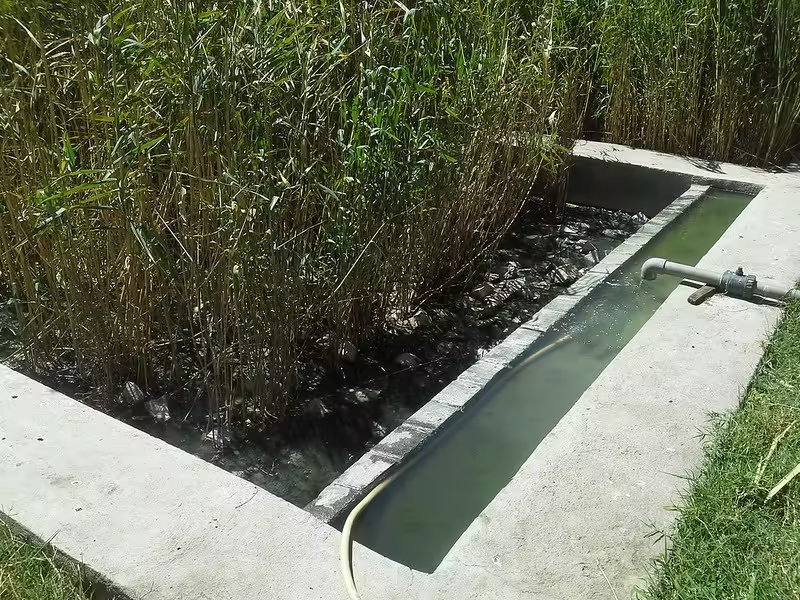
Did you know that nature has been purifying water for millions of years? Well, it’s time we took a page out of Mother Nature’s book! Wetland greywater biofilters nature’s very own water purification system. In this article, we’ll dive into how these eco-friendly marvels are revolutionizing wastewater treatment. Get ready to explore a solution that’s not just effective, but downright beautiful!
What is a Wetland Greywater Biofilter?
A wetland greywater biofilter is a carefully designed and constructed ecosystem that mimics natural wetlands to purify wastewater, specifically waste greywater from homes in this case. Greywater is all the wastewater from your sinks, showers, and washing machines, technically any household water that isn’t from your toilet. This water more often than not lives up to its name and is dirty, grey, and can smell quite bad but has potential and shouldn’t be wasted. Let’s break down the components of a wetland greywater biofilter.
- The wetland: The star of the show. It can be natural or constructed, but both types use a combination of water, soil, plants, and microorganisms to filter the water.
- Plants: Aquatic plants like cattails, reeds, and bulrushes aren’t just for show. They’re great at absorbing nutrients and providing a home for beneficial bacteria.
- Soil and substrate: This layer acts as a filter and a surface for helpful microbes to grow on.
- Microorganisms: Break down pollutants and transform nutrients.
- Water distribution system: This ensures that the greywater flows evenly through the biofilter.
There are also different types of wetlands you might be lucky enough to have a natural wetland which are existing wetland area adapted for water treatment. Then there are constructed wetlands, which are preferred for greywater filtering, in my opinion just in terms of possibly harming a preexisting ecosystem and that they are specifically designed for treating greywater. These can be further divided into surface flow and subsurface flow systems, each with its own benefits.
Wetland biofilters can pretty much handle most kinds of greywater from kitchen sink water, laundry runoff, and shower and bath water, all fair game for a wetland biofilter. However, it’s important to note that they’re not suitable for blackwater (toilet waste) or industrial wastewater, which need more intensive treatment.
The Science Behind Wetland Greywater Biofilters
Wetland biofilters are a mix of complex biological, physical, and chemical processes. Understanding them can be difficult, especially in practice when things aren’t going right and solutions aren’t showing results, yet knowing what’s happening can really make you appreciate the efficiency and effectiveness of these natural water treatment systems.
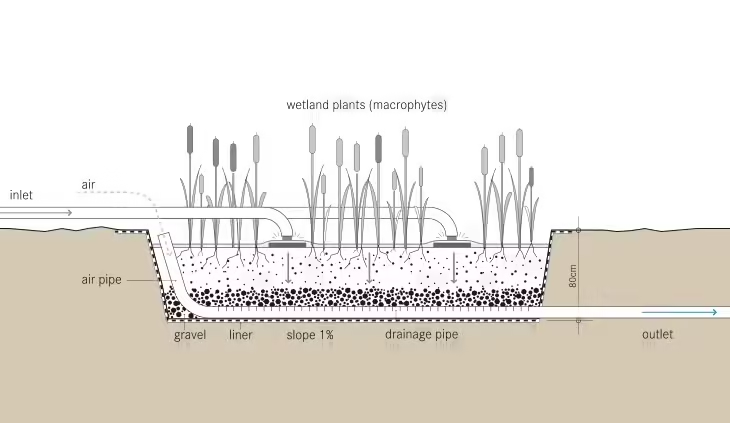
Biological Processes
At the core of every wetland biofilter is an ecosystem comprising plants, microorganisms, and soil, each playing a vital role in water purification:
- Plant Functions: Plants engage in phytoremediation, absorbing excess nutrients like nitrogen and phosphorus. Their roots also provide a substrate for beneficial bacteria, improving the overall treatment process.
- Microbial Activity: Bacteria and other microorganisms are essential for breaking down organic matter, transforming nutrients, and neutralizing certain pollutants. These processes happen continuously, contributing a lot to water purification.
- Soil Interactions: The soil and substrate in a wetland biofilter serve multiple purposes. They trap particles, provide surface area for microbial colonization, and facilitate various chemical transformations crucial to the treatment process.
Filtration, Sedimentation, and Absorption
Wetland biofilters use three primary mechanisms for water treatment:
- Filtration: As water flows through the system, larger particles are physically trapped by soil particles and plant roots.
- Sedimentation: Heavier particles settle to the bottom of the wetland, where they can be further broken down over time.
- Absorption: Plants and soil particles absorb dissolved pollutants and nutrients, removing them from the water column.
Nutrient Transformation and Removal
Nutrient management is a key function of wetland biofilters:
- Nitrogen Transformation: Through nitrification, ammonia is converted to nitrate. Subsequently, denitrification transforms nitrate into nitrogen gas, effectively removing it from the system.
- Phosphorus Retention: Phosphorus is trapped in the soil or absorbed by plants. Some specialized bacteria can store phosphorus, further aiding in its removal from the water.
- Carbon Cycling: Organic carbon compounds are decomposed by microorganisms, releasing carbon dioxide and creating new microbial biomass, thus completing the carbon cycle within the system.
Evapotranspiration
Another process in wetland biofilters is evapotranspiration where plants release water vapor through their leaves. This process helps to regulate water levels and can influence local microclimates. Wetland biofilters leverage these natural processes to achieve high pollutant removal rates. They can reduce biochemical oxygen demand (BOD) by up to 95%, remove 80% or more of suspended solids, and significantly decrease nitrogen and phosphorus levels. These kinds of systems and processes show the potential of natural systems to solve environmental challenges and how there are eco friendly and passive solutions to some of our biggest issues today
Benefits of Wetland Greywater Biofilters
For sustainable water management, it doesn’t get better than a wetland greywater biofilter. Their most obvious advantage is the fact that they can filter dirty water naturally with the only by product being that it grows and strengthens the system itself, but besides that these are some of the many other benefits you can look forward to.
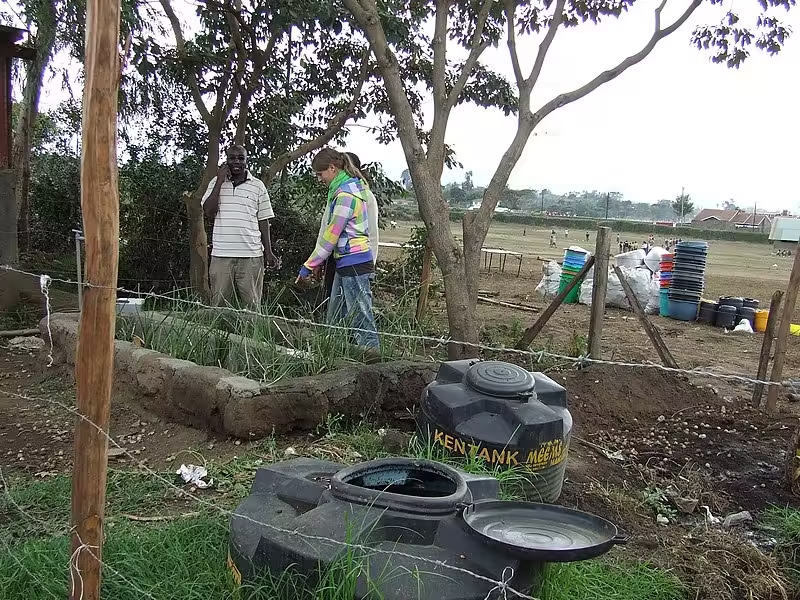
Water Conservation and Reuse
One of the main benefits of wetland greywater biofilters is their ability to conserve water resources.
- Greywater recycling: By treating and reusing greywater, they significantly reduce the demand for freshwater in non-potable applications like watering your garden.
- Groundwater recharge: Treated water can percolate into the ground, helping to replenish aquifers and maintain local water tables.
- Drought resilience: In areas prone to water scarcity, wetland biofilters are a reliable source of treated water for irrigation and other non-potable uses.
Energy Efficiency
Compared to normal wastewater treatment setups, wetland greywater biofilters are remarkably energy-efficient:
- Low-energy operation: These systems mostly rely on natural processes, requiring minimal external energy input. More often than not, greywater is delivered to the wetland biofilter by gravity.
- Reduced carbon footprint: Low energy demand means slower greenhouse gas emissions, contributing a lot to stopping climate change.
- Passive treatment: Once established, wetland biofilters can operate with minimal mechanical intervention, further reducing energy consumption.
Ecological Enhancement
Wetland greywater biofilters don’t just treat water, they create thriving ecosystems:
- Biodiversity boost: They provide a habitat for a variety of plant and animal species, enhancing local biodiversity.
- Wildlife corridors: In urban and suburban areas, wetland biofilters can serve as important links in green infrastructure networks.
- Ecosystem services: Beyond water treatment, these wetlands also improve air quality.
Aesthetic and Recreational Value
Wetland biofilters can be designed to be visually appealing and multifunctional:
- Landscape integration: They can be seamlessly incorporated into parks, gardens, and other green spaces.
- Educational opportunities: Wetland biofilters serve as living laboratories for environmental education and community engagement.
- Recreational spaces: When properly designed, these areas can offer recreational amenities such as walking trails or bird-watching spots.
Cost-Effectiveness
While initial installation costs may vary and as always size does matter, wetland greywater biofilters often prove cost effective in the long run:
- Low maintenance costs: Once established, they need little to no upkeep compared to conventional treatment plants.
- Longevity: With proper management, wetland biofilters can operate effectively for decades.
- Multifunctional value: The additional benefits provided, such as green space and habitat creation, add to the overall cost-effectiveness of these systems.
Climate Resilience
Wetland greywater biofilters help climate change adaptation strategies:
- Flood mitigation: These systems can act as natural buffers, absorbing excess water during heavy rainfall events.
- Urban heat island reduction: The vegetation and water bodies in wetland biofilters can help cool surrounding areas, mitigating the urban heat island effect.
- Carbon sequestration: The plants and soils in these systems can capture and store carbon dioxide, aiding in climate change mitigation.
Pollutant Removal Efficiency
Wetland greywater biofilters are highly effective at removing a wide range of pollutants:
- Organic matter reduction: These systems can significantly reduce biochemical oxygen demand (BOD) and chemical oxygen demand (COD).
- Nutrient removal: Wetland biofilters excel at removing excess nitrogen and phosphorus, helping to prevent eutrophication in receiving water bodies.
- Pathogen reduction: The natural processes in these systems can effectively reduce harmful bacteria and other pathogens.
Designing an Effective Wetland Greywater Biofilter
Some of the wetland greywater bio-filters I’ve seen have almost been thrown together on a whim by a property owner or landscaper without much thought or care, and become beautiful additions to a landscape but perform poorly as a biofilter. Always remember that getting a few key components right is really important when trying to get the best performance out of the wetland. These are some of those components I think are important and should be taken more seriously and touch more care.
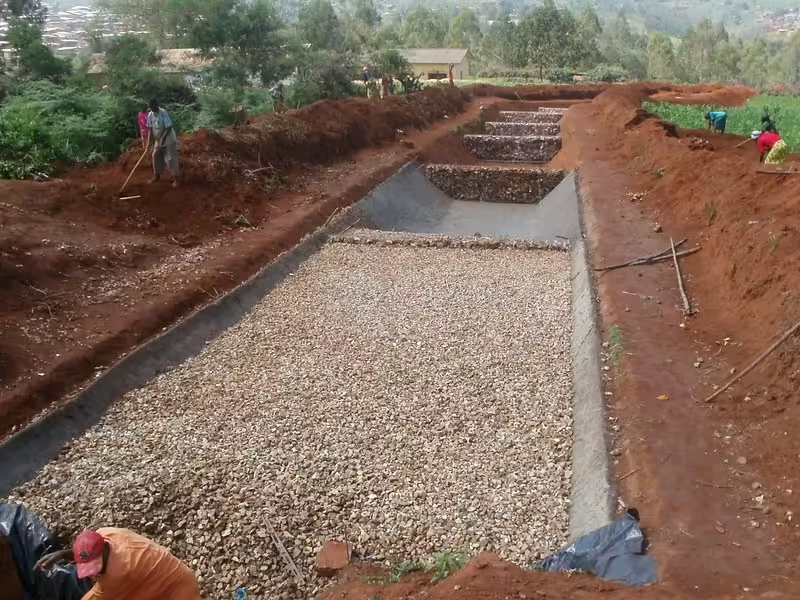
Site Assessment and Planning
Before breaking ground, a thorough site evaluation is crucial:
- Topography analysis: Assess the land’s natural contours to determine optimal water flow patterns.
- Soil characteristics: Check soil type, permeability, and composition to ensure proper filtration and plant growth.
- Climate considerations: Factor in local weather patterns, rainfall, and temperature ranges to select appropriate plants and design features.
- Space availability: Determine the area available for the biofilter and any constraints that might affect its size or shape.
Remember, a well-planned site assessment sets the foundation for a successful wetland greywater biofilter project.
Sizing and Hydraulic Loading Rates
Proper sizing is critical for optimal performance:
- Calculate daily greywater production: Estimate the volume of greywater your system will need to handle.
- Determine hydraulic loading rate: This is the amount of water that can be treated per unit area of the wetland.
- Design for peak flows: Ensure your system can handle occasional surges in water volume.
Tip: A general rule of thumb is to allow 1-2 square meters of wetland area per person for residential systems, but this can vary based on specific conditions and requirements.
Plant Selection for Optimal Performance
Choosing the right plants is essential for effective water treatment and ecosystem health:
- Native species: Prioritize plants adapted to your local climate and conditions.
- Root system diversity: Include plants with different root depths to maximize nutrient uptake.
- Treatment capacity: Select species known for their ability to remove specific pollutants.
- Aesthetic considerations: Balance functional plants with visually appealing varieties.
Some popular choices include:
- Cattails (Typha spp.)
- Bulrushes (Scirpus spp.)
- Reed canary grass (Phalaris arundinacea)
- Common reed (Phragmites australis)
Substrate Composition and Layering
The substrate acts as both a filter and a growth medium for beneficial microorganisms:
- Gravel layer: Place a layer of coarse gravel at the bottom for drainage.
- Sand layer: Add a layer of coarse sand above the gravel for finer filtration.
- Soil mixture: Top with a blend of sand, organic matter, and topsoil to support plant growth.
Pro tip: Ensure proper depth for each layer to optimize water flow and treatment efficiency.
Flow Distribution and Collection Systems
Effective water distribution is key to maximizing treatment efficiency:
- Inlet structure: Design an inlet that evenly distributes water across the wetland surface.
- Baffles or berms: Use these to create a meandering flow path, increasing retention time.
- Outlet structure: Implement a system that allows for water level control and easy sample collection.
Consider incorporating adjustable weirs or valves to manage water levels and flow rates effectively.
Monitoring and Control Systems
Integrate monitoring capabilities for ongoing performance assessment:
- Water quality sensors: Install devices to measure key parameters like pH, dissolved oxygen, and nutrient levels.
- Flow meters: Track water input and output to ensure proper hydraulic loading.
- Data logging system: Implement a method to record and analyze performance data over time.
Regular monitoring allows for timely adjustments and optimizations to maintain peak performance.
Safety and Accessibility Features
Don’t forget about human interaction with the system:
- Safety barriers: Install fencing or vegetation barriers to prevent accidental access to deeper water areas.
- Walkways and observation points: Create paths for maintenance access and educational opportunities.
- Signage: Place informative signs to educate visitors about the biofilter’s function and benefits.
Maintenance and Monitoring
I feel like half the fun in having things is looking after those things. Nothing will beat the feeling of a post-maintenance system working at its best. By creating and implementing a systematic approach to upkeep and performance tracking, you can extend the life and efficiency of any system including a wetland biofilter, which proudly holds the title of being a passive system. Yet a little love will still go a long way and is highly recommended.
Routine Maintenance Tasks
Regular maintenance helps prevent issues and keeps your biofilter functioning at its best:
- Vegetation management:
- Trim and prune plants as needed
- Remove invasive species
- Replant bare areas to maintain vegetation cover
- Inlet and outlet maintenance:
- Clear debris from inlet structures
- Clean distribution pipes
- Ensure outlet structures are functioning properly
- Sediment removal:
- Monitor sediment accumulation
- Remove excess sediment when necessary to prevent clogging
- Water level management:
- Adjust water levels seasonally if required
- Check for and repair any leaks in the system
Water Quality Testing
Regular water quality testing is essential to assess the biofilter’s performance:
- Key parameters to monitor:
- pH levels
- Biological Oxygen Demand (BOD)
- Total Suspended Solids (TSS)
- Nitrogen and phosphorus levels
- Fecal coliform counts
- Sampling frequency:
- Conduct tests monthly or quarterly, depending on system size and regulations
- Increase frequency if issues are detected
- Record keeping:
- Maintain detailed logs of all test results
- Use data to track long-term performance trends
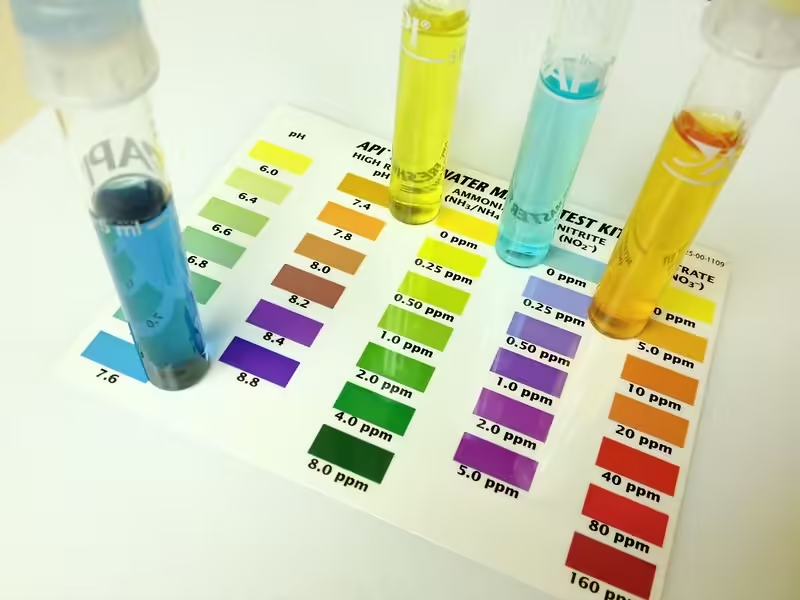
Troubleshooting Common Issues
Be prepared to address these potential problems:
- Poor water quality:
- Check for overloading or short-circuiting
- Assess plant health and coverage
- Verify proper flow distribution
- Odor problems:
- Investigate potential anaerobic conditions
- Ensure adequate oxygen levels in the system
- Mosquito breeding:
- Maintain proper water flow
- Consider introducing mosquito-eating fish if appropriate
- Plant die-off:
- Check for nutrient imbalances
- Assess water depth and flow patterns
- Consider replanting with more suitable species
Seasonal Considerations
Adapt your maintenance routine to seasonal changes:
- Spring:
- Remove dead plant material from winter
- Check for frost damage and replant if necessary
- Summer:
- Monitor water levels during dry periods
- Manage excessive plant growth
- Fall:
- Prepare the system for winter by trimming plants
- Clean inlet and outlet structures thoroughly
- Winter:
- Monitor ice formation and prevent damage to structures
- Adjust flow rates if necessary to prevent freezing
Performance Evaluation
Regularly assess your biofilter’s overall performance:
- Annual review:
- Analyze water quality data trends
- Assess plant health and coverage
- Review maintenance logs for recurring issues
- Efficiency calculations:
- Calculate pollutant removal rates
- Compare performance to design expectations
- Adaptive management:
- Implement changes based on performance data
- Consult experts if significant issues persist
Case Studies: Successful Implementations
A study done in India showed how common landscaping grass Axonopus compressus (broadleaf carpet grass) was used in constructed wetlands and performed very well with an average removal of 93% turbidity, 95% COD, 98% NO3−–N, 67% PO43−–P, and 95% of anionic surfactants. Not only did it perform well but the grass grew both in number and biomass.
Another study on the use of ornamental plants as biofilters also produced similar performance results and also touched on the payback period of having a biofilter and found that larger buildings like hotels had an average payback period of 2.5 years with smaller buildings going up to 7 years and single homes having to wait between 16 and 20 years. This shows how a whole community can benefit a lot quicker by investing in wetland biofilters, but this still shouldn’t undermine the importance it can have for small off-grid homes.
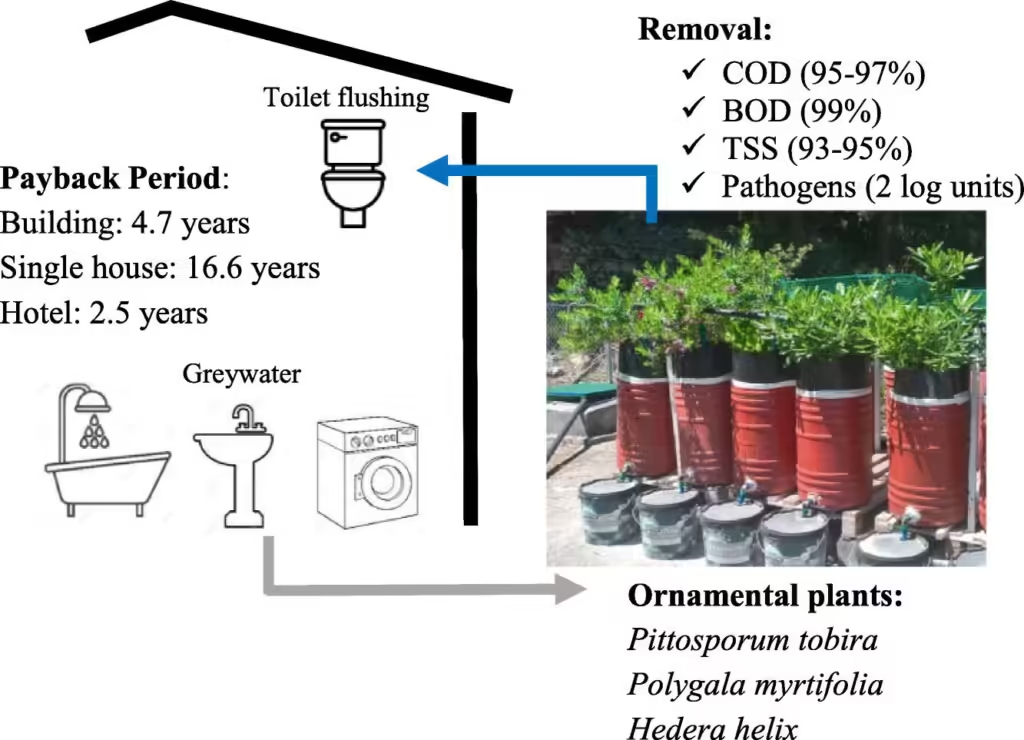
Challenges and Limitations of wetland greywater biofilters
Even though the benefits far outweigh the challenges and limitations, in my opinion. These are some of the issues that you should know about and understand beforehand.
Space Requirements
One of the main issues they pose is simply how much land they take up.
- Large footprint:
- Typically they need more space than conventional treatment systems
- can be challenging in urban or densely populated areas
- Land availability:
- May compete with other land uses in developed areas
- Could be cost-prohibitive in regions with high land values
Climate and Geographical Constraints
Environmental factors can significantly hurt the effectiveness of wetland biofilters:
- Temperature limitations:
- Cold climates can reduce microbial activity and plant growth.
- Freezing conditions can affect parts of the system.
- Rainfall patterns:
- Drought can stress plants and reduce treatment efficiency.
- Excessive rainfall may overwhelm the system’s capacity.
- Topography:
- Steep terrain can make construction and maintenance challenging.
- Flat areas may require pumping to ensure proper water flow.
Regulatory Hurdles
Implementing wetland biofilters often involves navigating complex regulations:
- Permitting processes:
- Can require multiple approvals from different agencies
- Can be time-consuming and costly
- Water Quality Standards:
- Must meet local and national effluent requirements
- Standards may vary depending on the intended use of treated water.
- Zoning restrictions:
- Some areas may have limitations on constructing wetlands.
- May require special variances or exemptions.
Maintenance Requirements
Ongoing care is essential for optimal performance:
- Regular monitoring:
- Requires consistent water quality testing
- May need specialized equipment or expertise
- Vegetation management:
- Plants need periodic trimming and replanting.
- Invasive species control can be hard work.
- Sediment removal:
- Periodic dredging may be necessary to maintain hydraulic capacity.
- Proper disposal of removed sediment can be challenging.
Public Perception and Education
Overcoming misconceptions and gaining community support can be difficult:
- Aesthetic concerns:
- Some may view wetlands as unattractive or unkempt.
- Educating about the natural appearance of healthy wetlands is crucial.
- Health and safety worries:
- Misconceptions about disease vectors like mosquitoes
- Concerns about odors or wildlife attractants
- Understanding the technology:
- The public may not grasp the science behind natural treatment systems.
- Requires ongoing education and outreach efforts
Performance Variability
Wetland biofilters can experience fluctuations in treatment efficiency:
- Seasonal changes:
- Performance may vary with temperature and rainfall patterns.
- Plant dormancy in winter can affect treatment capacity.
- Pollutant load variations:
- Sudden spikes in contaminants can overwhelm the system.
- May require additional pre-treatment or buffer capacity
- Long-term effectiveness:
- Treatment efficiency may decrease over time without proper maintenance.
- Aging systems may require renovation or replacement.
Initial Costs and Funding
While often cost-effective long term, initial expenses can be significant:
- Construction costs:
- Site preparation and earthwork can be expensive.
- Specialized materials and plants add to overall costs.
- Funding challenges:
- It may be difficult to secure financing for non-traditional systems.
- Grant opportunities may be limited or competitive.
Technical Expertise
Designing and managing wetland biofilters requires specialized knowledge:
- Interdisciplinary approach:
- Requires expertise in hydrology, botany, and environmental engineering, but smaller off-grid home options are definitely attemptable on your own.
- Finding qualified professionals can be challenging in some areas.
- Evolving technology:
- Best practices and design standards continue to develop.
- Staying current with research and innovations is crucial.
Future of Wetland Greywater Biofilters
With water becoming a more and more valuable resource and the never-ending growth of environmental concerns, wetland greywater biofilters could have a big part to play in the future of sustainable water management. These are some of the emerging trends that could help cut down on limitations and concerns, let alone improve the benefits.
Technological Advancements
Innovations are improving the efficiency and applicability of wetland biofilters:
- Smart monitoring systems:
- Real-time water quality sensors
- AI-powered predictive maintenance
- Automated flow control and optimization
- Enhanced filtration media:
- Engineered biochar for improved pollutant removal
- Nano-materials for targeting specific contaminants
- Recycled materials for sustainable construction
- Vertical and modular designs:
- Space-saving configurations for urban environments
- Scalable systems adaptable to various settings
- Green wall integrations for building facades
Integration with Smart Cities
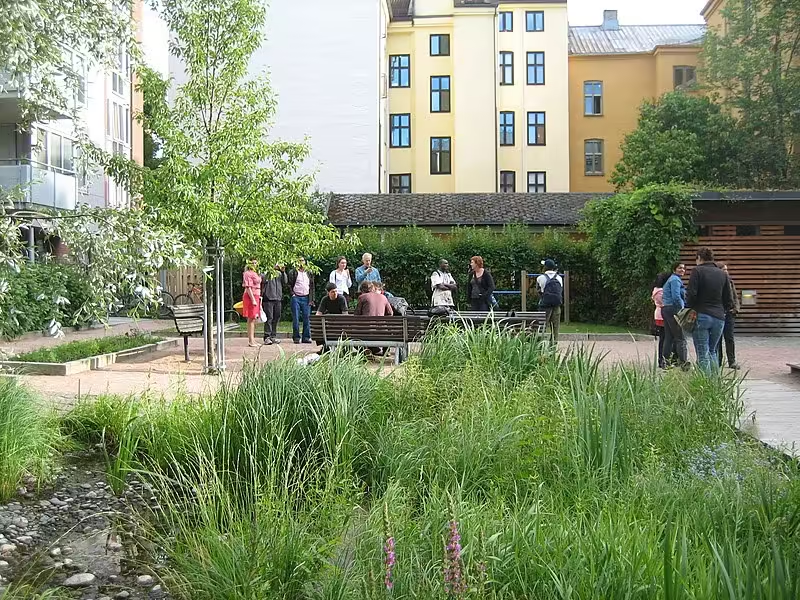
Wetland biofilters are becoming integral in urban planning:
- Decentralized water treatment:
- Neighborhood-scale systems reduce strain on central infrastructure
- Integration with smart water grids
- Real-time data sharing for city-wide water management
- Multi-functional green spaces:
- Combination of water treatment, recreation, and biodiversity
- Climate resilience through flood mitigation and urban cooling
- Enhanced property values and community well-being
Climate Change Adaptation
Biofilters are evolving to meet future environmental challenges:
- Drought-resistant designs:
- Selection of climate-adaptive plant species
- Water-efficient configurations and recycling systems
- Integration with rainwater harvesting technologies
- Flood resilience:
- Increased capacity to handle extreme weather events
- Dynamic systems adjusting to varying water levels
- Protective barriers for urban areas
Emerging Applications
New uses for wetland biofilters are being explored:
- Industrial wastewater treatment:
- Tailored systems for specific industries (e.g., textiles, food processing)
- Recovery of valuable resources from wastewater
- Compliance with increasingly stringent environmental regulations
- Agricultural runoff management:
- Large-scale systems for treating agricultural drainage
- Nutrient recovery for fertilizer production
- Reduction of harmful algal blooms in water bodies
- Pharmaceutical contaminant removal:
- Specialized wetlands targeting emerging pollutants
- Combination with advanced oxidation processes
- Mitigation of antibiotic resistance in the environment
Policy and Regulatory Developments
Evolving policies are likely to impact the adoption of wetland biofilters:
- Incentive programs:
- Tax benefits for green infrastructure implementation
- Grants and subsidies for wetland biofilter projects
- Water reuse credits in water-scarce regions
- Updated regulations:
- Stricter effluent standards driving natural treatment adoption
- Inclusion of wetland biofilters in building codes
- Standardization of design and performance criteria
Research and Development Focus
Ongoing studies are expanding the potential of wetland biofilters:
- Microbial ecology:
- Understanding and enhancing beneficial microbial communities
- Bioaugmentation for improved treatment efficiency
- Microbiome engineering for specific pollutant degradation
- Plant breeding and selection:
- Development of high-performance plant varieties
- Genetic modification for enhanced pollutant uptake
- Exploration of native species for regional applications
- System modeling and optimization:
- Advanced computational fluid dynamics simulations
- Machine learning for performance prediction and optimization
- Life cycle assessment tools for sustainable design
Education and Public Awareness
Increasing knowledge dissemination will drive adoption:
- Academic programs:
- Interdisciplinary courses on natural water treatment systems
- Research partnerships between universities and industry
- Online courses and certifications for professionals
- Public engagement:
- Interactive educational displays at wetland biofilter sites
- Citizen science projects for monitoring and data collection
- Social media campaigns highlighting success stories
Global Expansion
Wetland biofilters are gaining traction worldwide:
- Adaptation to diverse climates:
- Tropical wetland systems for developing countries
- Arid region designs for water-scarce areas
- Cold climate modifications for Northern regions
- International cooperation:
- Knowledge-sharing platforms for global best practices
- Cross-border projects for shared water resources
- Technology transfer initiatives for developing nations
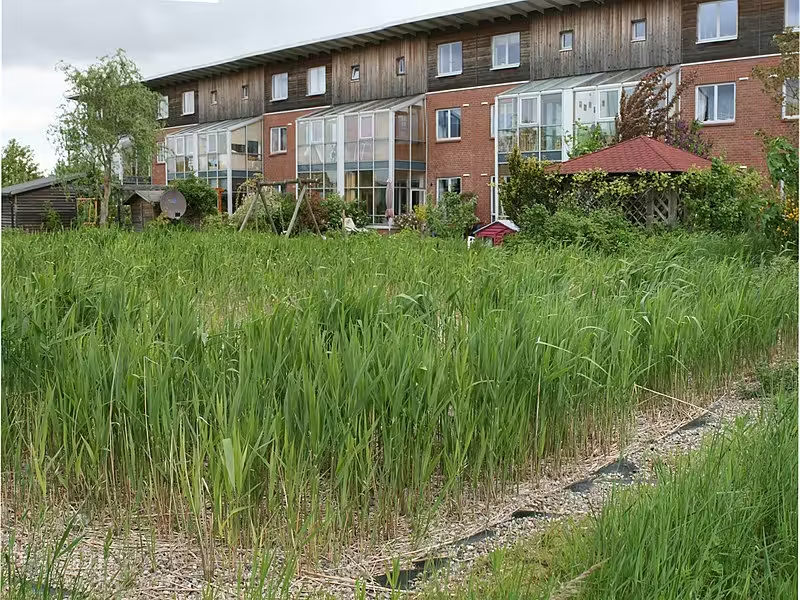
As we’ve seen, wetland greywater biofilters are more than just a eco-friendly trend – they’re a powerful tool in our quest for sustainable water management. By mimicking nature’s time-tested methods, we’re not only cleaning our water but also creating beautiful, living ecosystems in the process. Ready to make a splash in the world of water conservation? Consider implementing a wetland greywater biofilter in your next project – your wallet and the planet will thank you!
